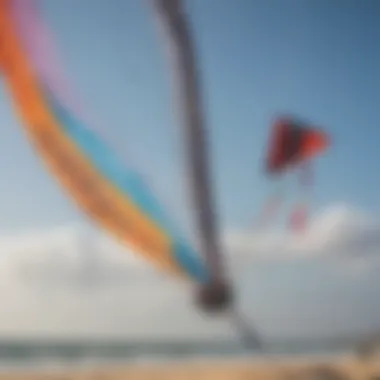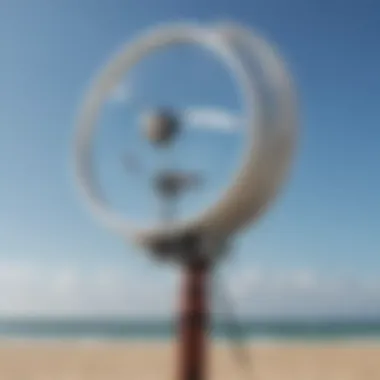The Impact of Wifi Wind Meters on Kiteboarding


Intro
Kiteboarding is a thrilling sport, where the ebb and flow of wind dictates every move. In this fast-paced environment, having the right tools at your disposal can make a world of difference. Enter wifi wind meters, which are becoming game-changers for both novices and seasoned kiteboarders alike. These devices, equipped with advanced technology, help riders understand wind patterns and conditions, allowing for safer and more proficient riding.
One can think of a wifi wind meter as the weather-savvy buddy you want by your side. Its ability to transmit data to your smartphone or tablet in real-time ensures you are not flying blind with your kite. With a wifi wind meter, the sport feels more predictable and less risky, allowing you to focus on the joy of riding.
In the following sections, we will dive into techniques to harness the potential of these meters effectively, followed by a look at the current gear options on the market that can enhance your kiteboarding experience.
Techniques
When it comes to kiteboarding, knowing the wind speed and direction is half the battle won. That brings us to understanding the techniques that can give you better control and enjoyment while riding the waves.
Beginner Kiteboarding Techniques
For those just stepping into the kiteboarding world, using a wifi wind meter can be incredibly helpful. Here are some techniques aimed at beginners:
- Understanding Wind Patterns: Knowing whether the wind is steady or gusty can make or break your session. Use the data from your wind meter to choose the right kite size for the conditions.
- Practice Launching and Landing: With the right wind conditions logged, practice your launch and landing techniques. Setting up in optimal wind can smooth your experience and improve confidence.
- Kite Control Basics: As you start to get comfortable in the air, remember that a wifi wind meter can guide your learning process. Monitoring wind speed lets you know when to pull harder or ease off your control bar.
Advanced Freestyle Maneuvers
Once you’ve gained some ground in the fundamentals, moving to advanced techniques is the next step. At this level, the wifi wind meter can serve as an analytical tool for riders pushing their limits:
- Refining Tricks: Use data to identify patterns before attempting that next big trick. For example, if you notice that the wind drops before a gust, you might want to time your jumps accordingly.
- Wind Timing: For maneuvers like handle passes or rotations, timing is critical. Being aware of changing wind conditions through the meter can enhance your execution and help avoid mishaps.
- Spotting Safe Landing Areas: Constant awareness of where the wind is blowing can help you determine the best spots to land, keeping you safe while boosting your confidence for more difficult tricks.
"Understanding the wind is like learning a language; it speaks volumes when you listen carefully."
With foundational skills powered by the insights from wifi wind meters, kiteboarders can navigate from beginner days to impressive stunts with grace and safety. However, techniques are only as good as the gear that supports them.
Understanding Wifi Wind Meters
In the dynamic world of kiteboarding, the influence of meteorological factors cannot be overstated. Among those, wind conditions hold paramount importance. This is where wifi wind meters come into play, acting as crucial instruments for kiteboarders to gauge wind speed, direction, and overall conditions.
Wifi wind meters capture essential data, allowing users to understand their environment and optimize their performance on the water. The benefits of using these devices are manifold. They empower riders, whether they are beginners or seasoned pros, to make informed decisions that can significantly enhance their experience. Moreover, accessing real-time data through wifi connections extends the potential for safety, ensuring that kiteboarders can respond swiftly to changing conditions.
Definition and Functionality
Wifi wind meters are specialized devices designed to measure wind characteristics, integrating advanced technology for accurate results. At their core, these meters typically feature an anemometer to determine wind speed and a wind vane for direction. The data collected is then transmitted via wifi to smartphones or tablets, where users can analyze the information in real-time.
These meters operate on simple principles; they capture wind flow and convert it into measurable units, like miles per hour or kilometers per hour. The real magic, though, lies in their connectivity. They remove the need for cumbersome cables or manual logging of data, allowing kiteboarders to focus on riding rather than guessing the wind conditions.
How Wifi Technology Enhances Measurements


The integration of wifi technology into wind meters transforms the way these devices function. Traditional measuring instruments required manual checking, often leading to human error or misinterpretation of the data. With wifi, the process becomes seamless.
Users can receive instantaneous updates on wind conditions right on their devices, providing them the ability to adjust their setups or even choose alternate locations based on precise information. This immediacy can be a real game-changer, especially when conditions change swiftly. Moreover, since these wind meters connect to the internet, some devices also offer community features, allowing users to report conditions or check recent sharing, which contributes to collective knowledge among kiteboarders.
Key Components of Wifi Wind Meters
Understanding the essential parts of wifi wind meters is crucial for anyone looking to invest in these devices. Here are a few key components:
- Anemometer: This component measures wind speed and is often equipped with rotating blades that catch the wind.
- Wind Vane: Used for determining wind direction. It allows the kiteboarder to understand which way the wind is blowing, critical for steering.
- Wifi Module: The heart of connectivity in the device, enabling data transmission to smartphones or tablets.
- Battery: Most modern meters come with rechargeable batteries, ensuring long-term usage without frequent replacements.
- Display Unit/App: This is where users can see the data collected, making it user-friendly and intuitive.
Importance of Accurate Wind Measurement
Accurate wind measurement is like the best kind of compass for kiteboarding—it guides every move and helps prevent mishaps on the water. When you're out there riding the waves, wind conditions can shift faster than a sand dune in a storm. Understanding this element is not just beneficial but crucial.
Impact on Kiteboarding Performance
For kiteboarders, the wind is both friend and foe. The right wind can send you soaring, while the wrong gust can quickly turn a perfect day into a disaster. Having precise data on wind speed and direction allows riders to make informed decisions regarding their kite size and technique. If the wind is at your back, you want to be on your game, optimizing your movements.
- Improved Maneuverability: With accurate wind information, kiteboarders can spot the right windows for jumps and tricks. Without that edge, it's like trying to hit a moving target with a blindfold on.
- Tailored Gear Choices: Choosing the right kite based on real-time measurements can drastically affect performance. You wouldn’t show up to a water fight with a squirt gun in a hurricane, would you?
Safety Considerations
Safety can't be overstated. Kiteboarding in unpredictable winds is a recipe for trouble. Remember the times when unexpected gusts caught you off guard? Those moments can lead to accidents, injuries, and potential damage to gear. Accurate wind measurements help in making crucial decisions that can mean the difference between a thrilling ride and a harrowing experience.
- Risk Mitigation: Data from wifi wind meters enables riders to foresee changes in wind patterns, allowing them to adjust their plans accordingly. One ill-timed position on the water could lead to get stuck in dangerous conditions.
- Emergency Preparedness: Knowledge of local wind conditions can aid emergency services too. If a rider is in trouble, knowing the wind can help first responders navigate safely and efficiently to a person in need.
Connection to Real-Time Data
Thanks to wifi connectivity, kiteboarders now have access to real-time wind data that can be a game changer. Gone are the days of squinting into the horizon for signs of a breeze.
- Instant Updates: Fast and reliable updates mean less guesswork for riders. Why rely on an outdated weather app when you can tap into direct data that changes as rapidly as the wind?
- Enhanced Collaboration: By connecting with fellow kiteboarders, you can share live updates, turning wind conditions into a community effort. Sharing winds reports while shredding waves can foster a sense of camaraderie that enhances the experience for everyone involved.
Accurate measurements and real-time feedback ensure kiteboarders stay ahead of the game, making decisions based on facts rather than hunches.
In summary, accurate wind measurement is fundamental for kiteboarders not only to enhance their performance but to prioritize safety. The connection between kiteboarders and reliable data allows for a richer, more intelligent riding experience.
Features of Wifi Wind Meters
In the world of kiteboarding, the specifics can make or break an experience. It's in this context that wifi wind meters become indispensable tools. By focusing on essential features, kiteboarders can understand what to look for when choosing a wifi wind meter. Each characteristic contributes to how well it serves its purpose, ensuring safety and enhancing performance on the water.
Measurement Range and Accuracy
One of the most critical aspects of wifi wind meters is their measurement range and accuracy. A wind meter that measures from anywhere between 0 to 70 mph might sound impressive, but it’s the precision at which it functions that ultimately matters.


Most meter users will agree that it’s not just about how much wind there is; it’s about knowing how that wind affects their performance. Equipment like the Kestrel 5500, for instance, is known for delivering accurate readings across various conditions. This accuracy allows kiteboarders to adjust their strategies promptly, tailoring their kite choice and riding techniques according to real-time data.
For those new to kiteboarding, consider a meter with good resolution in lower wind conditions. Too often, readings that are off by a hair can lead to decisions that impact the riding experience significantly.
Data Transmission and Connectivity
In an age where information is just a touch away, wifi wind meters offer some remarkable advancements in data transmission and connectivity. Many of these devices can sync with smartphones, tablets, or laptops, allowing immediate access to readings without needing to squint at the tiny screen during a ride.
Imagine being out on the water and having all your wind data streamed to your phone. It’s not just about convenience; it fosters better decision-making. Users can analyze trends, pinpoint optimal riding times, and share info with friends or teammates almost instantly. Brands like Veho have taken this further by providing apps that allow users to track data over time, enabling long-term insights into their kiteboarding environment.
User-Friendly Interfaces
Lastly, let’s talk about user-friendly interfaces. A high-tech gadget is only as good as the experience it provides. When looking at various wifi wind meters, it’s important to consider how easily someone can interact with the device.
Most users prefer clear displays with intuitive navigation. Features such as backlit screens, large fonts, and touch controls can elevate the overall usability, especially when you are in a rush to make adjustments. Moreover, some models offer voice control features, which can be a game changer for kiteboarders already juggling gear and safety.
A practical example here is the Sailing Performance Wind Meter, renowned for its simple, accessible design, making it easy even for less tech-savvy riders. Still, while ease of use is vital, balancing it with functionality and advanced features is equally necessary.
"In kiteboarding, knowledge is power. A good wifi wind meter doesn’t just carry information; it empowers riders to seize the optimal moment in the wind."
With that in mind, understanding these features can lead to a more enjoyable experience on the water, reducing the guesswork and letting kiteboarders truly focus on their ride.
Choosing the Right Wifi Wind Meter
Selecting the right wifi wind meter plays a crucial role in maximizing kiteboarding experiences. Kiteboarding isn’t just about the thrill; it requires keen awareness of wind conditions for optimal performance and safety. A suitable wind meter ensures that you’re well-informed about the weather elements you’re dealing with on the water. This is particularly essential for both novices and seasoned kiteboarders who are looking to push their limits, with special focus on safety and efficiency.
Key Factors to Consider
When choosing a wifi wind meter, various features come to the forefront. These include:
- Accuracy and Calibration: Ensure the device offers precise measurements. A wind meter that’s not accurately calibrated can lead to poor performance or even dangerous situations.
- Measurement Range: Consider the wind speed range that the device can measure. It should adequately cover the conditions you frequently encounter.
- Data Connectivity: A stable and fast wifi connection allows you to view updates in real-time, which is vital while you’re out on the water.
- Durability: Waterproof and robust designs help withstand the harsher environmental conditions kiteboarders often face.
- User Interface: A straightforward and intuitive interface is important, especially for beginners who might find complex settings intimidating.
These factors help ensure that the wind meter you select aligns with your specific kiteboarding needs, ultimately enhancing performance.
Comparison of Top Models
There are several wifi wind meters available that cater to different preferences and budgets. Here’s a snapshot of a few noteworthy options:
- Kestrel 5500: Renowned for its dependable accuracy, it offers a wide measurement range and durable construction. It's a favorite among many experts and amateurs alike.
- WeatherFlow Smart Weather Meter: This model stands out due to its advanced connectivity features, allowing users to easily share data and access historical trends. It's an excellent choice for data enthusiasts.
- Anemometer by SAILOR: A solid choice for beginners. It has a simplified interface and is remarkably lightweight, making it easy to transport.
By comparing these models, you can identify which one aligns best with your kiteboarding lifestyle, taking into account your unique preferences and the specific conditions you encounter while kiting.
User Reviews and Recommendations


User experiences often shed light on the practical functionalities of these devices. Many kiteboarders recommend testing the wind meter in conditions that are similar to real-world usage before making a final decision.
Some kiteboarders highlight the Kestrel 5500, noting its reliability in varying conditions, while others prefer the sharing capabilities of the WeatherFlow Smart Meter. Moreover, reviews on platforms like Reddit and kiteboarding forums provide insight into user satisfaction, further guiding potential buyers. Combining expert advice with user insights can help in making an informed choice.
“The right wind meter is not just a gadget; it’s a crucial companion that can save you from missed opportunities on the water or even potential hazards.”
Overall, understanding what features matter most, comparing your options, and seeking user reviews can streamline the process of choosing the right wifi wind meter, making it a tailored fit for every kiter.
Practical Applications in Kiteboarding
The way kiteboarders interact with wind is crucial for mastering this exhilarating sport. Wifi wind meters provide useful data that can transform one’s kitesurfing experience. Their practical applications are numerous, whether on the water, at home, or integrated with other equipment.
On-the-Water Usage
Using wifi wind meters while kiteboarding can significantly improve performance. Imagine riding the waves with a reliable device that constantly delivers wind speed and direction. It gives you the ability to make swift decisions, ensuring you ride with optimal conditions. For instance, if a kiteboarder sees the wind speed increasing, they might feel the urge to switch to a larger kite to harness that power.
Moreover, tracking real-time changes helps in understanding wind patterns. Experienced kiteboarders often say, "Feeling the wind" is one thing, but having a gadget that quantifies it allows for a more precise approach. It's akin to having an edge in competitive scenarios; knowing how the wind behaves could mean the difference between a solid maneuver or a miscalculation. This is particularly handy during teaching sessions, where instructors can better educate learners about adapting to live wind conditions.
Home Wind Monitoring
Wifi wind meters aren’t just helpful while out on the water; their application starts well before even stepping outside. Kiteboarders can monitor wind conditions from home. This capability means you can check whether the wind will be favorable for a session later in the day.
With features that link to smartphones or tablets, these devices allow for easy access to past and present wind conditions. As a result, you save time and energy by avoiding trips to the beach when conditions aren’t suitable. This information can be particularly advantageous for kiteboarding instructors, as it enables them to plan lessons more effectively. Knowing when to prioritize theory over practice can enhance the learning experience for students.
Integration with Other Equipment
The functionality of wifi wind meters expands significantly when used alongside other kiteboarding gear. Many modern systems allow for integrations with GPS tracking devices, kite control systems, and even weather stations. This interconnectedness means a more in-depth analysis of the conditions while riding. For example, synchronized data from a GPS unit and a wind meter can provide kiteboarders with vital insights into their speed relative to wind speed.
Furthermore, this integration helps in optimizing setup adjustments. A kiteboarder can check if their adjustments align well with current wind conditions – think of it like fine-tuning an instrument to ensure perfect harmony. When combining data sets, the potential for enhancing kiteboarding performance and safety skyrockets.
"Utilizing technology through proper integration can transform a kiteboarder's experience from basic to extraordinary."
Culmination
In the grand scheme of kiteboarding, the significance of wifi wind meters cannot be understated. They serve as a bridge between raw data and informed decision-making, empowering kiteboarders to optimize their performance while ensuring safety on the water. This article sheds light on several critical aspects: from the functionality and features of wifi wind meters to their practical applications.
Recap of the Benefits
To sum up, the utility of wifi wind meters is manifold:
- Enhanced Performance: Consistent access to accurate wind data enables riders to make better choices about when to hit the water. Knowing the wind conditions can mean the difference between a thrilling ride and an exhausting struggle.
- Safety Assurance: Accurate readings help kiteboarders understand local wind conditions better, reducing the risks associated with sudden gusts or variable winds.
- Convenient Integration: Many models can sync with smartphones or other devices, allowing users to manage and monitor their wind data effortlessly.
- Informed Decision-Making: Real-time data lets riders evaluate whether it's a good day for kiteboarding or if they should wait it out. This can be particularly advantageous for those who travel to specific locations for the sport.
The above points highlight why investing in a wifi wind meter is not just a luxury, but rather a necessity for serious kiteboarders.
Future Trends in Wind Measurement
As technology continues to evolve, several trends are emerging that are likely to shape the future of wind measurement:
- Smart Technology Integration: Expect more advanced models that integrate seamlessly with smart home systems. Imagine setting your home system to alert you when optimal wind conditions arise.
- AI and Machine Learning: Future models may employ machine learning algorithms to analyze wind patterns and predict upcoming changes, offering unprecedented insights.
- User Customization Features: Upcoming trends will likely announce more user-friendly interfaces with customizable settings. This means each kiteboarder can tailor their wind measurements to their personal preferences—whether that’s wind angle, speed, or other critical metrics.
- Accessory Connectivity: Future wind meters might pair with other kiteboarding gear, offering a comprehensive analysis of performance metrics during each ride.







